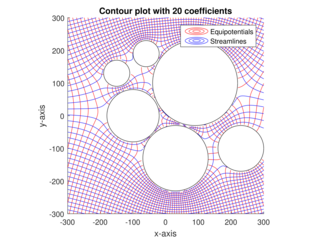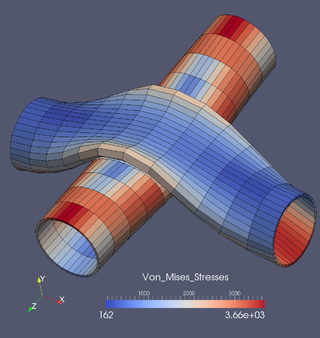Related Research Articles
Numerical methods for partial differential equations is the branch of numerical analysis that studies the numerical solution of partial differential equations (PDEs).

The analytic element method (AEM) is a numerical method used for the solution of partial differential equations. It was initially developed by O.D.L. Strack at the University of Minnesota. It is similar in nature to the boundary element method (BEM), as it does not rely upon the discretization of volumes or areas in the modeled system; only internal and external boundaries are discretized. One of the primary distinctions between AEM and BEMs is that the boundary integrals are calculated analytically. Although originally developed to model groundwater flow, AEM has subsequently been applied to other fields of study including studies of heat flow and conduction, periodic waves, and deformation by force.

Computational electromagnetics (CEM), computational electrodynamics or electromagnetic modeling is the process of modeling the interaction of electromagnetic fields with physical objects and the environment using computers.
Electromagnetic field solvers are specialized programs that solve Maxwell's equations directly. They form a part of the field of electronic design automation, or EDA, and are commonly used in the design of integrated circuits and printed circuit boards. They are used when a solution from first principles or the highest accuracy is required.
The fast multipole method (FMM) is a numerical technique that was developed to speed up the calculation of long-ranged forces in the n-body problem. It does this by expanding the system Green's function using a multipole expansion, which allows one to group sources that lie close together and treat them as if they are a single source.
In the numerical solution of partial differential equations, a topic in mathematics, the spectral element method (SEM) is a formulation of the finite element method (FEM) that uses high degree piecewise polynomials as basis functions. The spectral element method was introduced in a 1984 paper by A. T. Patera. Although Patera is credited with development of the method, his work was a rediscovery of an existing method
In mathematics, in particular numerical analysis, the FETI method is an iterative substructuring method for solving systems of linear equations from the finite element method for the solution of elliptic partial differential equations, in particular in computational mechanics In each iteration, FETI requires the solution of a Neumann problem in each substructure and the solution of a coarse problem. The simplest version of FETI with no preconditioner in the substructure is scalable with the number of substructures but the condition number grows polynomially with the number of elements per substructure. FETI with a preconditioner consisting of the solution of a Dirichlet problem in each substructure is scalable with the number of substructures and its condition number grows only polylogarithmically with the number of elements per substructure. The coarse space in FETI consists of the nullspace on each substructure.

The finite element method (FEM) is a popular method for numerically solving differential equations arising in engineering and mathematical modeling. Typical problem areas of interest include the traditional fields of structural analysis, heat transfer, fluid flow, mass transport, and electromagnetic potential.
hp-FEM is a generalization of the finite element method (FEM) for solving partial differential equations numerically based on piecewise-polynomial approximations employing elements of variable size (h) and polynomial degree (p). hp-FEM originates from the discovery by Barna A. Szabó and Ivo Babuška that the finite element method converges exponentially fast when the mesh is refined using a suitable combination of h-refinements (dividing elements into smaller ones) and p-refinements. The exponential convergence of hp-FEM has been observed by numerous independent researchers. On many problems, hp-FEM may be faster than finite element methods that converge at an algebraic rate.

In numerical analysis, the singular boundary method (SBM) belongs to a family of meshless boundary collocation techniques which include the method of fundamental solutions (MFS), boundary knot method (BKM), regularized meshless method (RMM), boundary particle method (BPM), modified MFS, and so on. This family of strong-form collocation methods is designed to avoid singular numerical integration and mesh generation in the traditional boundary element method (BEM) in the numerical solution of boundary value problems with boundary nodes, in which a fundamental solution of the governing equation is explicitly known.
In applied mathematics, the boundary particle method (BPM) is a boundary-only meshless (meshfree) collocation technique, in the sense that none of inner nodes are required in the numerical solution of nonhomogeneous partial differential equations. Numerical experiments show that the BPM has spectral convergence. Its interpolation matrix can be symmetric.
In scientific computation and simulation, the method of fundamental solutions (MFS) is a technique for solving partial differential equations based on using the fundamental solution as a basis function. The MFS was developed to overcome the major drawbacks in the boundary element method (BEM) which also uses the fundamental solution to satisfy the governing equation. Consequently, both the MFS and the BEM are of a boundary discretization numerical technique and reduce the computational complexity by one dimensionality and have particular edge over the domain-type numerical techniques such as the finite element and finite volume methods on the solution of infinite domain, thin-walled structures, and inverse problems.
In numerical mathematics, the boundary knot method (BKM) is proposed as an alternative boundary-type meshfree distance function collocation scheme.
In numerical mathematics, the regularized meshless method (RMM), also known as the singular meshless method or desingularized meshless method, is a meshless boundary collocation method designed to solve certain partial differential equations whose fundamental solution is explicitly known. The RMM is a strong-form collocation method with merits being meshless, integration-free, easy-to-implement, and high stability. Until now this method has been successfully applied to some typical problems, such as potential, acoustics, water wave, and inverse problems of bounded and unbounded domains.
The Kansa method is a computer method used to solve partial differential equations. Its main advantage is it is very easy to understand and program on a computer. It is much less complicated than the finite element method. Another advantage is it works well on multi variable problems. The finite element method is complicated when working with more than 3 space variables and time.

GetFEM++ is a generic finite element C++ library with interfaces for Python, Matlab and Scilab. It aims at providing finite element methods and elementary matrix computations for solving linear and non-linear problems numerically. Its flexibility in choosing among different finite element approximations and numerical integration methods is one of its distinguishing characteristics.
The multilevel fast multipole method (MLFMM) is used along with method of moments (MoM) a numerical computational method of solving linear partial differential equations which have been formulated as integral equations of large objects almost faster without loss in accuracy. This method is an alternative formulation of the technology behind the MoM and is applicable to much larger structures like radar cross-section (RCS) analysis, antenna integration on large structures, reflector antenna design, finite size antenna arrays, etc., making full-wave current-based solutions of such structures a possibility.
Christoph Schwab is a German applied mathematician, specializing in numerical analysis of partial differential equations and boundary integral equations.

The method of moments (MoM), also known as the moment method and method of weighted residuals, is a numerical method in computational electromagnetics. It is used in computer programs that simulate the interaction of electromagnetic fields such as radio waves with matter, for example antenna simulation programs like NEC that calculate the radiation pattern of an antenna. Generally being a frequency-domain method, it involves the projection of an integral equation into a system of linear equations by the application of appropriate boundary conditions. This is done by using discrete meshes as in finite difference and finite element methods, often for the surface. The solutions are represented with the linear combination of pre-defined basis functions; generally, the coefficients of these basis functions are the sought unknowns. Green's functions and Galerkin method play a central role in the method of moments.
References
- ↑ In electromagnetics, the more traditional term "method of moments" is often used, though not always, as a synonymous of "boundary element method": see ( Gibson 2008 ) for further information on the subject.
- ↑ The boundary element method is well suited for analyzing cracks in solids. There are several boundary element approaches for crack problems. One such approach is to formulate the conditions on the cracks in terms of hypersingular boundary integral equations, see ( Ang 2013 ).
- ↑ Pohrt, R.; Li, Q. (2014-10-01). "Complete boundary element formulation for normal and tangential contact problems". Physical Mesomechanics. 17 (4): 334–340. doi:10.1134/S1029959914040109. ISSN 1029-9599. S2CID 137494525.
- ↑ "BEM Based Contact Pressure Calculation Tutorial". www.tribonet.org. 9 November 2017.
- ↑ Chow, Y. L.; Yang, J. J.; Fang, D. G.; Howard, G. E. (March 1991). "A closed-form spatial Green's function for the thick microstrip substrate". IEEE Transactions on Microwave Theory and Techniques. 39 (3): 588–592. Bibcode:1991ITMTT..39..588C. doi:10.1109/22.75309.
- ↑ Aksun, M. I. (February 2003). "A robust approach for the derivation of closed-form Green's functions". IEEE Transactions on Microwave Theory and Techniques. 44 (5): 651–658. doi:10.1109/22.493917. hdl: 11693/10779 .
- 1 2 Teo, Swee-Ann (2000). "Discrete complex image method for Green's functions of general multilayer media". IEEE Microwave and Guided Wave Letters. 10 (10): 400–402. doi:10.1109/75.877225.
- 1 2 Teo, Swee-Ann; Chew, Siou-Teck; Leong, Mook-Seng (February 2003). "Error analysis of the discrete complex image method and pole extraction". IEEE Transactions on Microwave Theory and Techniques. 51 (2): 406–412. Bibcode:2003ITMTT..51..406T. doi:10.1109/TMTT.2002.807834.
- ↑ See ( Katsikadelis 2002 ).
- ↑ Kolaei, Amir; Rakheja, Subhash; Richard, Marc J. (2015-09-01). "Three-dimensional dynamic liquid slosh in partially-filled horizontal tanks subject to simultaneous longitudinal and lateral excitations". European Journal of Mechanics B. 53: 251–263. Bibcode:2015EJMF...53..251K. doi:10.1016/j.euromechflu.2015.06.001.
- ↑ Kolaei, Amir; Rakheja, Subhash; Richard, Marc J. (2015-01-31). "A coupled multimodal and boundary-element method for analysis of anti-slosh effectiveness of partial baffles in a partly-filled container". Computers & Fluids. 107: 43–58. doi:10.1016/j.compfluid.2014.10.013.
- ↑ Kolaei, Amir; Rakheja, Subhash; Richard, Marc J. (2014-11-14). Volume 4A: Dynamics, Vibration, and Control. pp. V04AT04A067. doi:10.1115/IMECE2014-37271. ISBN 978-0-7918-4647-6.
- ↑ Popov, Valentin (2017). Contact Mechanics and Friction - Physical Principles and (Chapter 19). Springer. pp. 337–341. ISBN 9783662530801.
- ↑ Pohrt, Roman; Popov, Valentin L. (2015-04-09). "Adhesive contact simulation of elastic solids using local mesh-dependent detachment criterion in boundary elements method". Facta Universitatis, Series: Mechanical Engineering. 13 (1): 3–10.
- ↑ Najarzadeh, L., Movahedian, B. and Azhari, M., 2022. Numerical solution of water wave propagation problems over variable bathymetries using the modified radial integration boundary element method. Ocean Engineering, 257, p.111613.
- ↑ Najarzadeh, L., Movahedian, B. and Azhari, M., 2019. Numerical solution of scalar wave equation by the modified radial integration boundary element method. Engineering Analysis with Boundary Elements, 105, pp.267-278.